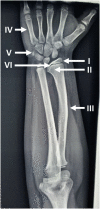SHOX deficiency in children with growth impairment: evaluation of known and new auxological and radiological indicators
- PMID: 33143726
- PMCID: PMC7640664
- DOI: 10.1186/s13052-020-00927-z
SHOX deficiency in children with growth impairment: evaluation of known and new auxological and radiological indicators
Abstract
Background: The phenotypic features of SHOX deficiency (SHOX-D) are highly variable and can be very mild, especially in young children. The aim of this retrospective study was to evaluate auxological and radiological indicators that could be predictive of SHOX-D in children.
Methods: Molecular analysis of the SHOX gene was performed in 296 subjects with growth impairment or skeletal disproportion, without alternative diagnosis. Auxological variables and radiographs of the hand, wrist and forearm were evaluated.
Results: SHOX mutations (88% inherited, 12% de novo) were identified in 52 subjects. The most predictive auxological indicators of SHOX-D were an increased sitting height/height ratio and a decreased arm span/height ratio. The convexity of distal radial metaphysis at X-ray, not yet reported in literature, was also found to be predictive of SHOX-D. In young children, stratification of data by bone age also highlighted ulnar tilt, lucency of the ulnar border of the distal radius and enlarged radius as the radiological signs most related to SHOX-D .
Conclusions: In this study, the analysis of auxological and radiological indicators in SHOX-D children allowed to identify an additional early radiological sign and underlines the importance of family auxological evaluation.
Keywords: Convexity of distal radial metaphysis; Growth impairment; SHOX.
Conflict of interest statement
The authors declare no competing interests.
Figures


References
-
- Rao E, Weiss B, Fukami M, Rump A, Niesler B, Mertz A, Muroya K, Binder G, Kirsch S, Winkelmann M, Nordsiek G, Heinrich U, Breuning MH, Ranke MB, Rosenthal A, Ogata T, Rappold GA. Pseudoautosomal deletions encompassing a novel homeobox gene cause growth failure in idiopathic short stature and turner syndrome. Nat Genet. 1997;16(1):54–63. doi: 10.1038/ng0597-54. - DOI - PubMed
-
- Marchini A, Marttila T, Winter A, Caldeira S, Malanchi I, Blaschke RJ, Häcker B, Rao E, Karperien M, Wit JM, Richter W, Tommasino M, Rappold GA. The short stature homeodomain protein SHOX induces cellular growth arrest and apoptosis and is expressed in human growth plate chondrocytes. J Biol Chem. 2004;279(35):37103–37114. doi: 10.1074/jbc.M307006200. - DOI - PubMed

